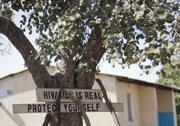HIV rates up by half
HIV rates in Australia have increased by almost fifty percent in the past eight years - according to a national report compiled by UNSW researchers.
HIV rates in Australia have increased by almost fifty percent in the past eight years - according to a national report compiled by UNSW researchers.

HIV rates in Australia have increased by almost fifty percent in the past eight years -according to a national report compiled by UNSW researchers.
Overall, the number of new HIV diagnoses in Australia has increased each year from 718 in 1999 to 1,051 in 2007.
Significantly, the report sheds light on migrants and returning Australians, by showing that in 2007, one in ten newly-reported infections in Australia were originally diagnosed overseas.
In common with other Western countries people born in sub-Saharan countries now resident in Australia have substantially higher rates of HIV/AIDS diagnosis than among Australian-born people, reflecting Africa as the epicentre of the global HIV epidemic. Sixty percent of cases of infection attributed to heterosexual contact were in people from high prevalence countries or their sexual partners.
The findings are contained in the HIV/AIDS, viral hepatitis and sexually transmissible infections in Australia Annual Surveillance Report, which has been prepared by researchers from UNSW's National Centre in HIV Epidemiology and Clinical Research (NCHECR) for the Commonwealth Department of Health and Ageing.
The report is one of two from UNSW released at the annual conference of the Australasian Society for HIV Medicine.
Other findings include:
The second report, by UNSW researchers at the National Centre in HIV Social Research, the HIV/AIDS, hepatitis and sexually transmissible infections in Australia Annual report of trends in behaviour 2008 shows that among those diagnosed with HIV infection across all states, about two-thirds are currently receiving treatment.
The report shows:
Media Contact: Susi Hamilton | 0422 934 024 | susi.hamilton@unsw.edu.au